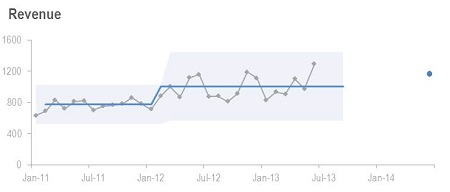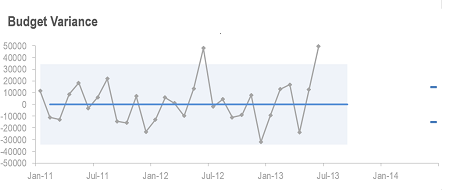Three Types of Useful KPI Targets
by Stacey Barr |I fundamentally disagree that we should be striving to hit our KPI targets each month (or whatever frequency we measure at). Natural variability guarantees it’s purely a fluke if we hit a target in any given month. We need targets to make more sense.

The pursuit of snapshot KPI targets – numbers we try to hit each day or week or month – is like riding a roller coaster. Up and down and over and under, virtually at random. Targets like these don’t drive improvement; they drive us to exhaustion.
They ignore the fact that everything has its own pattern of natural variability. Performance is never exact and precise. If we want to make performance improve, we need to account for variability in how we interpret where performance currently is, and how we set sensible targets.
This is why I use XmR charts. They tell a more truthful and useful story about performance compared to target. And they make it clear how to set three types of targets that are useful for driving improvement that lasts.
1. Targets for the average level of performance.
We’re interested in moving performance in a specific direction. For example:
- Increasing monthly customer satisfaction from an average of 6.5 to an average of 8.0 on a 10-point scale.
- Decreasing the amount of weekly rework from an average of 4 hours per employee to an average of 2 hours per employee.
So a sensible target for this situation is a target for the central line (a proxy for the current level of performance) in our measure’s XmR chart.

2. Targets for the predictability of performance.
We’re interested in making performance less variable. For example:
- Reducing the variability of spending relative to budget from +\- $35K to +\- $10K.
- Reducing the variability of the time it takes to relocate employees to new jobs from 5 to 120 days, down to 2 to 30 days.
So a sensible target for this situation is a target for both the upper and lower natural process limits (a proxy for the natural amount of variation in performance) in our measure’s XmR chart. It’s a target for a range, and also known as tolerances or specification limits.

Incidentally, when we reduce variability in a measure, very often we also get a natural improvement in its average level of performance too.
3. Targets for thresholds of performance.
We’re interested in moving performance above a particular level, or below a particular level. For example:
- Increase system uptime so it’s never below a weekly average of 98%
- Reduce the number of workplace injuries so it’s never above 5 per month
So a sensible target for this situation is a target for either the upper or the lower natural process limit in our measure’s XmR chart.

Get off the variation explanation roller coaster.
If you’re hitting a monthly target every single month, then you don’t really have a target. Performance is already better than the target. And if you’re constantly either hitting a monthly target or missing it, then your attention isn’t on performance; it’s on a silly numbers game.
Think about targets as a tool to improve capability, not effort. And set useful targets to drive capability-improving behaviour.
DISCUSSION:
What’s your organisation’s track record of reaching targets and truly driving capability improvement, rather than a numbers game?
Connect with Stacey
Haven’t found what you’re looking for? Want more information? Fill out the form below and I’ll get in touch with you as soon as possible.
167 Eagle Street,
Brisbane Qld 4000,
Australia
ACN: 129953635
Director: Stacey Barr




